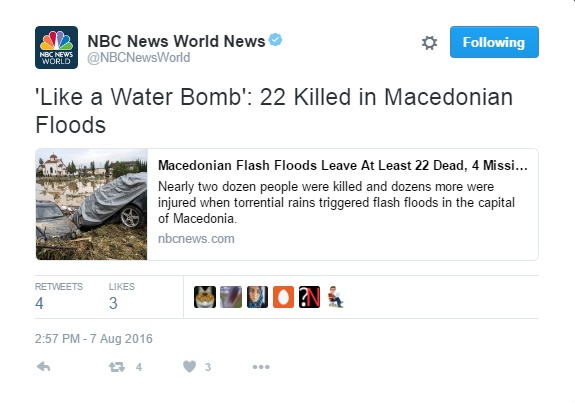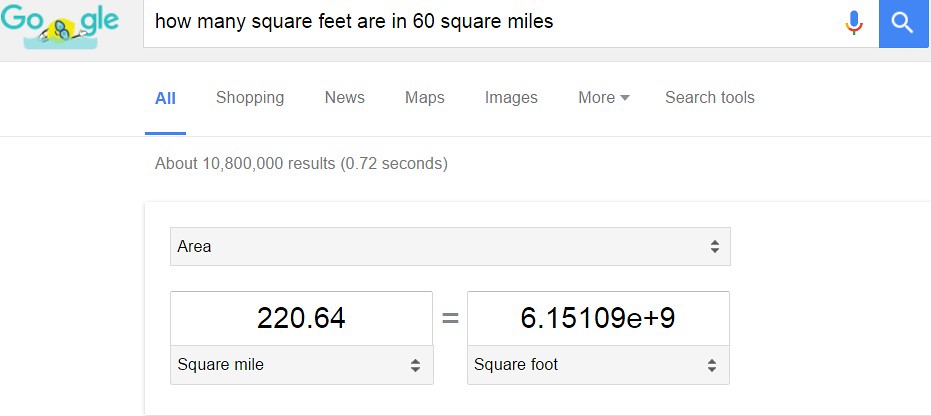How Large Is Skopje?
According to the news site "ABC.com", the capital of Macedonia -- Skopje received an enormous amount of rainfall over the last few days. Here is the picture taken from Twitter to describe the story:
Upon clicking the link, the story titled "Macedonian Flash Floods Leave At Least 22 Dead, 4 Missing" contains catastrophic volumes of rainfall reported. Here is an excerpt describing the tragedy that has hit the country:
Nearly two dozen people were killed and dozens more were injured when torrential rains triggered flash floods in the capital of Macedonia, the Red Cross said Sunday.Government spokesman Aleksandar Gjorgiev told The Associated Press a state of emergency had been declared for two weeks in the most affected areas, which included the capital of Skopje, the city of Tetovo and surrounding suburbs.The Red Cross reported that 22 people were killed, more than 60 people were injured and four were still missing after the floods destroyed hundreds of homes and wiped out electricity. More than 1,000 people were evacuated from their houses, according to the Red Cross.
Any loss of life is tragic and unfortunate. The article goes onto report a total of 20 inches falling in parts of the city of Skopje. That seems like a large amount of rain, but the size of the region should be known in order to put the volume of rain into perspective. If "Wikipedia" is consulted, the city of Skopje is reported to be around 220.64 square miles in size. Wow. Considering the size of the rainfall the disaster due to the volume of rainfall is slowly coming into perspective.
Why do I say this?
If you have followed the previous calculations, these numbers will add up to an enormous volume.
Recent floods in regions like China and Mexico have produced extraordinary volumes of rainfall that have caused considerable damage. Although, in China, the rainfall was spread out over a larger geographical area -- which resulted in a larger amount of damage to the country's overall GDP.
In order to really compare the volumes, a few calculations need to be carried out. Typically, I like to calculate the total volume of rainfall in cubic feet. The reason I choose to express the total volume in in cubic feet is that the height can easily be calculated from inches. Furthermore, having he volume expressed in units of gallons expands the direct comparisons that are possible -- since the majority of volumes that are reported in the news are either reported in units of 'gallons' or 'cubic feet.'
With that in mind, the area of Skopje which is expressed in units of 'square miles' needs to be converted to 'square feet.' I decided to use Google.com to convert for me. This entails typing in a question like: "How many square feet are in a square mile?"
If you do that for 220 square miles, the result is shown below in an image:
What do the numbers in the image above mean?
For every 220.64 square miles, there are 6.15 billion square feet. That is a conversion factor.
If you were to replace the 220.64 square mile by 1 square mile, the answer on the right hand side of the equal sign would be the conversion factor. This would be the number to multiply to get to square feet.
Now that the amount of square feet of Skopje is known, the remaining parameter is the height along with an expression to calculate the volume of the rainfall. To begin with, the expression for the volume of rain across a given square foot area with a certain height is shown below:
From the information reported coupled with the results of the calculations, the expression for the volume of the rainfall can be calculated as shown below:
Note: the value of 1.67 ft is the converted reported value of 20 inches into units of feet. The above calculation states that across the city of Skopje a total volume of 10.3 billion cubic feet of rain was reported -- Wow. The volumes keep getting larger compared to Mexico with 836 million cubic feet. Although, the value is small compared to 580 billion cubic feet for China. Still, the amount of rainfall has caused considerable damage across the region and therefore cannot be understated. The same can be said for the torrential rain in Huauchinango (Mexico) with loss of life too.
Next, in order to compare with values of volumes expressed in units of 'gallons', the volume needs to be converted as shown below:
The result of the conversion states that in 10.3 billion cubic feet of water, there is a corresponding 76.8 billion gallons of water. These two values are enormous and incomprehensible. As with other blog posts on this site, a little dimensional analysis is necessary to put the volumes into perspective.
First, in light of the Olympic Games taking place in Rio over the next few weeks, why don't we use the volume of an Olympic Size Swimming pool as a metric?
Hopefully, this will allow us to more easily visualize the volume of water produced in the calculations above.
How Many Olympic Pools Could Be Filled?
The question that needs to be answered in this section is the following:
How many Olympic Size Swimming pools can be filled with 76.8 billion gallons of water?
In order to start the calculation, the volume of an Olympic Size Swimming pool needs to be known. If you are a returning reader of the blog, you are probably thinking the following: "Mike, as we know, the volume used in previous calculations is 660,000-gallons" You (the reader) are correct. We know this from previous blogs and the first blog (which can be found here).
There is nothing magical about the volume -- which can be found on "Wikipedia" along with the reference to the image of an Olympic Size Swimming pool shown below:
Source: Ahl Baku
With the volume expressed in units of 'gallons' and the total volume (76.8 billion gallons) expressed in units of 'gallons' -- a simple dividing of the two values yield the number of swimming pools which would be filled with the rainfall:
The result indicates that a total of 116,363-Olympic Size Swimming pools could be filled with the volume of 76.8 billion gallons of water.
Does that seem reasonable to you?
Don't worry, unless you have been reading previous blog posts on the site that deal with large volumes of liquids, the guess might not come naturally.
Is there another volume that be used to visualize the enormous number?
How about the Mercedez Benz Superdome in Louisiana?
Below are the calculations for the superdome.
How Many Superdomes Would Be Filled?
The Mercedez Benz Superdome is an indoor football stadium located in Louisiana and is shown below:
Source: Wikipedia
As you can see, the structure is huge and seems like a reasonable metric to use in dimensional analysis calculations. According to the 'Wikipedia' page, the interior volume of the superdome is 125 million cubic feet. Since the calculation above for the volume was initially expressed in units of 'cubic feet' (10.3 billion cubic feet), the two numbers simply need to be divided as shown below:
Wow! Wow! Wow! Unbelievable. When you stop to consider that the amount of water that fell from the sky could fill 82 superdome structures, your mind should be blown away. At least mine was. I am still in disbelief.
Where does all the water come from?
This highlights the amount of water in the atmosphere.
Conclusion...
The amount of water that has fallen in the form of rainfall over the past few months is truly mind boggling to say the least. Unparalleled is the devastation through the disaster that is caused to infrastructure, life (loss of life), government, etc. The situation is without explanation by science -- except to say that climate is changing throughout the world. If this is a sign then, Wow -- we had better start thinking about solutions very quickly. The harm done to society is getting worse. Most of the fallout of the destruction from all of the rainfall remains to be seen. I am not just talking about Macedonia, but of the following recent floods: China, Mexico, and Maryland (USA). Not to mention the man made disasters that are caused by the unwillingness of our members of the world to engage with science and start offering solutions through policy changes.
One of the over arching goals of this site is to demystify science for everyone. Teach others how to perform calculations -- just in case you were wondering how to calculate the amount of rainfall that a storm dropped on a given region. The solution may not be exact, but is with approximations that are given in the underlying assumptions. The steps of defining a problem, give values to parameters, then evaluate the solution is a large part of science. A crucial one indeed. I hope that you have enjoyed the posts on the volume of rainfall along with other dimensional analysis posts.
I truly believe that an educated society is a society that will inhabit a healthier environment and community. Lets work together to make the world a better place through educating ourselves. Have a great day.










No comments:
Post a Comment